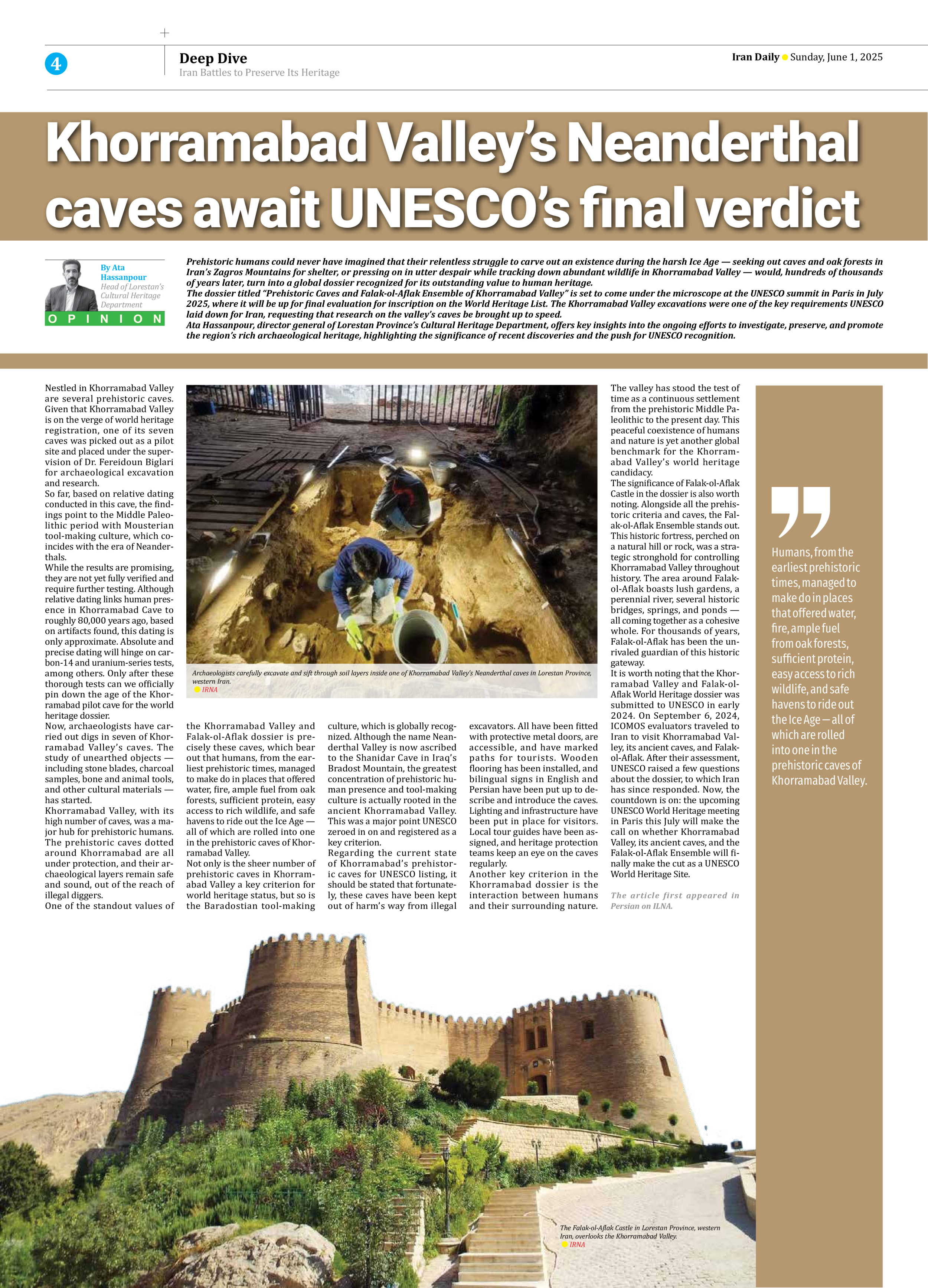
Khorramabad Valley’s Neanderthal caves await UNESCO’s final verdict
Prehistoric humans could never have imagined that their relentless struggle to carve out an existence during the harsh Ice Age — seeking out caves and oak forests in Iran’s Zagros Mountains for shelter, or pressing on in utter despair while tracking down abundant wildlife in Khorramabad Valley — would, hundreds of thousands of years later, turn into a global dossier recognized for its outstanding value to human heritage. The dossier titled “Prehistoric Caves and Falak-ol-Aflak Ensemble of Khorramabad Valley” is set to come under the microscope at the UNESCO summit in Paris in July 2025, where it will be up for final evaluation for inscription on the World Heritage List. The Khorramabad Valley excavations were one of the key requirements UNESCO laid down for Iran, requesting that research on the valley’s caves be brought up to speed. Ata Hassanpour, director general of Lorestan Province’s Cultural Heritage Department, offers key insights into the ongoing efforts to investigate, preserve, and promote the region’s rich archaeological heritage, highlighting the significance of recent discoveries and the push for UNESCO recognition.
By Ata Hassanpour
Head of Lorestan’s Cultural Heritage Department
Nestled in Khorramabad Valley are several prehistoric caves. Given that Khorramabad Valley is on the verge of world heritage registration, one of its seven caves was picked out as a pilot site and placed under the supervision of Dr. Fereidoun Biglari for archaeological excavation and research.
So far, based on relative dating conducted in this cave, the findings point to the Middle Paleolithic period with Mousterian tool-making culture, which coincides with the era of Neanderthals.
While the results are promising, they are not yet fully verified and require further testing. Although relative dating links human presence in Khorramabad Cave to roughly 80,000 years ago, based on artifacts found, this dating is only approximate. Absolute and precise dating will hinge on carbon-14 and uranium-series tests, among others. Only after these thorough tests can we officially pin down the age of the Khorramabad pilot cave for the world heritage dossier.
Now, archaeologists have carried out digs in seven of Khorramabad Valley’s caves. The study of unearthed objects — including stone blades, charcoal samples, bone and animal tools, and other cultural materials — has started.
Khorramabad Valley, with its high number of caves, was a major hub for prehistoric humans. The prehistoric caves dotted around Khorramabad are all under protection, and their archaeological layers remain safe and sound, out of the reach of illegal diggers.
One of the standout values of the Khorramabad Valley and Falak-ol-Aflak dossier is precisely these caves, which bear out that humans, from the earliest prehistoric times, managed to make do in places that offered water, fire, ample fuel from oak forests, sufficient protein, easy access to rich wildlife, and safe havens to ride out the Ice Age — all of which are rolled into one in the prehistoric caves of Khorramabad Valley.
Not only is the sheer number of prehistoric caves in Khorramabad Valley a key criterion for world heritage status, but so is the Baradostian tool-making culture, which is globally recognized. Although the name Neanderthal Valley is now ascribed to the Shanidar Cave in Iraq’s Bradost Mountain, the greatest concentration of prehistoric human presence and tool-making culture is actually rooted in the ancient Khorramabad Valley. This was a major point UNESCO zeroed in on and registered as a key criterion.
Regarding the current state of Khorramabad’s prehistoric caves for UNESCO listing, it should be stated that fortunately, these caves have been kept out of harm’s way from illegal excavators. All have been fitted with protective metal doors, are accessible, and have marked paths for tourists. Wooden flooring has been installed, and bilingual signs in English and Persian have been put up to describe and introduce the caves. Lighting and infrastructure have been put in place for visitors. Local tour guides have been assigned, and heritage protection teams keep an eye on the caves regularly.
Another key criterion in the Khorramabad dossier is the interaction between humans and their surrounding nature. The valley has stood the test of time as a continuous settlement from the prehistoric Middle Paleolithic to the present day. This peaceful coexistence of humans and nature is yet another global benchmark for the Khorramabad Valley’s world heritage candidacy.
The significance of Falak-ol-Aflak Castle in the dossier is also worth noting. Alongside all the prehistoric criteria and caves, the Falak-ol-Aflak Ensemble stands out. This historic fortress, perched on a natural hill or rock, was a strategic stronghold for controlling Khorramabad Valley throughout history. The area around Falak-ol-Aflak boasts lush gardens, a perennial river, several historic bridges, springs, and ponds — all coming together as a cohesive whole. For thousands of years, Falak-ol-Aflak has been the unrivaled guardian of this historic gateway.
It is worth noting that the Khorramabad Valley and Falak-ol-Aflak World Heritage dossier was submitted to UNESCO in early 2024. On September 6, 2024, ICOMOS evaluators traveled to Iran to visit Khorramabad Valley, its ancient caves, and Falak-ol-Aflak. After their assessment, UNESCO raised a few questions about the dossier, to which Iran has since responded. Now, the countdown is on: the upcoming UNESCO World Heritage meeting in Paris this July will make the call on whether Khorramabad Valley, its ancient caves, and the Falak-ol-Aflak Ensemble will finally make the cut as a UNESCO World Heritage Site.
The article first appeared in
Persian on ILNA.







